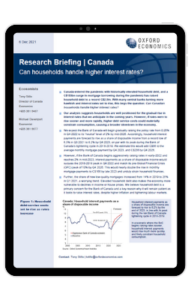Can Canadian households handle higher interest rates?

Canada entered the pandemic with historically elevated household debt, and a C$193bn surge in mortgage borrowing during the pandemic has raised household debt to a record C$2.5tn. With many central banks turning more hawkish and interest rates set to rise, this begs the question: Can Canadian households handle higher interest rates?
What you will learn:
- Our analysis suggests households are well positioned for the gradual rise in interest rates that we anticipate in the coming years.
- We expect the Bank of Canada will begin gradually raising the policy rate from 0.25% in Q4 2022 to its “neutral” level of 2% by mid-2026.
- However, if the Bank of Canada begins aggressively raising rates in early-2022 and reaches 2% in mid-2023, interest payments as a share of disposable income would surpass the 2018-2019 peak in Q4 2022 and match its pre Global Financial Crisis (GFC) peak of 10% by Q4 2026.
Tags:
Related Services

Post
House prices continue to slide for China’s cities
Research Briefing Can Canadian households handle higher interest rates? While the property market downturn has been universal, the scale and depth has been varied for different cities and regions.
Find Out More
Post
The Construction Productivity Challenge in Australia
Delve into the state of construction productivity in Australia. Understand the factors affecting growth and how innovation can transform the industry for the better.
Find Out More